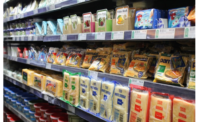Retailers Expand Private Brands to Build Customer Loyalty
Retailers hope to gain share by taking their own product lines to new levels of sophistication.


Brookshire Spices is a banner brand with the retailer’s logo on the package. It also includes a handtag label to stand out and drive authenticity in a category that is usually understated and functional.

Fresh Direct provides small batch, quality products offered exclusively online. This line has a brand look rather than a typical private label approach.

Giant Eagle’s Market District is a premium line of products owned and exclusive to Giant Eagle grocers. It is an example of personality-driven, authentic branding.




These days, most retailers prefer that their own line of products be called private brands, not private-label products. Many might even call these products a store brand or own brand. Indeed, there has been considerable evolution in this segment of the market.
No longer are retailers slapping a rather generic yellow label on a can or box and pricing it well below national brands. Private brands cross all segments of consumer packaged goods—from food and beverage to hardware. In many cases, they rival national brands in quality, design and breadth.
In recent years, many retailers have redesigned their product lines so that they truly are brands with their own value propositions, quality specifications, logos, packaging standards and pricing strategies. These private brands may even be formulated to appeal to different consumer groups. These may include value brands based on low prices to premium brands that appeal to upscale audiences built on exciting, new flavors or personal needs, such as gluten-free.
Private brands have experienced substantial growth since the recession hit in 2008-2009. A Nielson study shows that the private-label share of retail sales grew from 16.2 percent to 17.4 percent. This is attributed to hard-hit consumers who turned to the private brands in their search for value as earnings stagnated or dipped during the recession.
PRIVATE BRANDS AT CROSSROADS
Now, however, the U.S. economy is improving, and consumers are looking beyond price. According to a recent Nielsen report on the global retail landscape, consumers are identifying quality, availability and convenience as key factors in their purchase decisions. So, the report continues, while private-label growth was slightly greater than that of brands since 2012, growth patterns reversed in 2015 and into 2016, resulting in flat to slightly declining private-brand share.
Doug Baker, vice president of industry relations at the Food Marketing Institute (FMI), confirms that private brands may see a sales decline in 2016. However, he says, private brands have gained a foothold among consumers and are not likely to lose substantial share among shoppers. He attributes the drop to other factors. “We are now selling food through more channels than you can imagine. The pie is being cut in so many ways.”
The Nielsen research also demonstrates high consumer interest in store brands. Nearly 70 percent of total U.S. households consider store brands a good alternative to name-brand products, and private-brand products can be found in most U.S. households.
Despite the recent slowdown in private-brand sales, an increasing number of retailers are launching their own lines. The nation’s largest retailers—companies such as Walmart, Target, Costco, Kroger, Walgreens and Albertsons-Safeway—all have established and thriving private brands. Regional grocers such as Wegmans and Publix are respected for their multiple tiers of private brands. Trader Joe’s and Aldi—owned by the same German company—have established private brands as the basis of their entire business. Even online retailer Amazon recently announced that it will soon promote and sell its own brands like Happy Belly (nuts, trail mix, tea), Presto! (household goods), and Mama Bear (baby items). At the same time, it has launched seven branded clothing lines.
Lee Gobbi, creative director at Galileo Branding, a division of Daymon Worldwide, says the term “private brands” is really more of an industry term than a consumer term. He says consumers tend to see retailers’ brands as just another regular name brand, as long as the product quality is similar.
Customers don’t care who owns a brand, according to Christopher Durham, vice president of retail brands at Theory House and an author, consultant, strategist and retailer. “They don’t know most of the time. If the average customer knew that Burt’s Bees is owned by Clorox, how would they feel about that? Many also assume the product is manufactured by the brand owner, but it could be made by any number of co-manufacturers. For instance, Apple designs its products in Cupertino, Calif. but manufacturing is outsourced to China.”
Gobbi says the strategy is to improve the strength of the retailer’s brand while gaining equity and penetration. Baker of FMI says private brands help the retailer gain loyal customers and establish differentiation in the market. “The bottom line is that large retailers want to own as much shelf space as possible with their own brands, yet it is difficult to battle national brands that are paying slotting fees for premium shelf positions,” Gobbi says.
“There’s no expectation that you’re going to choose my store over someone else’s. The strategy shift has been toward saying ‘I have to create my own brand. I need you to come to me,’” says Durham.
RETAILERS VALUE PRIVATE BRANDS
Whether the product is food, beverage, clothing, electronics or lawn tools, a successful private brand allows the retailer higher profits on products that are cheaper to manufacture and market, especially if they are high-demand products. When the retailer establishes a reputation for quality and value pricing, customers will come to that store whether they recognize the brand name or not.
Private brands are not limited only to food and beverage. For example, Ace Hardware is a chain of 4,000 independently owned home improvement stores. The company stocks some 10,000 SKUs in its private label lines across a wide variety of tools, household and other items.
Cindy Brasic, Ace Hardware’s global private label manager, says the company launched a complete brand redesign across all categories after using the previous design for nearly 20 years. Increasingly, Ace Hardware’s private-label products are specifically sought out by customers for their quality, durability and value. The company’s private brands include Ace, Living Accents, Celebrations, OakBrook Collection, Home Plus, Steel Grip and Grill Mark. These brands accounted for a significant portion of the corporation’s $4.8 billion annual revenues in 2015.
While staying true to the overall essence of the Ace brand, Brasic pointed out how the private brands are customized to their specific category. As an example, she points to the line of Ace weed killers, all sold in rigid plastic containers with improved nozzles and images of the types of weeds against which they are effective. On the other hand, she explains how the redesign has worked with Ace Private Label Brand Bird Seed, a product popular among birding hobbyists. The new packaging features a clear bag that shows the high quality of the bird seeds. It is printed with nature scenes and images of the type of birds that will be attracted by the seed mix. The bags also are color color-coded by seed type.
Designing brands and packaging for so many product types can be a daunting task. She says Ace has conducted extensive research on the redesign, receiving input from consumer, the independent store owners and corporate teams. The company does employ the services of an onsite design team from R.R. Donnelley, saying her group provides the vision based on Ace Hardware’s values, and the Donnelley team develops new packaging renditions.’
Right now, outside of groceries, there is a lot more energy around private brands, according to Durham. He relates how Target successfully redesigned a kids’ brand called Circo that’s been around since the 1990s. They developed two new brands: Pillow Fort, a home décor brand for kids, and Cat & Jack, a fashion line for children. A recent Bloomberg article says: “Target is taking what amounts to a great leap of faith for a lumbering, 1,800-store retailer: throwing out what’s worked and opening its sales to the winds of trends and the whims of children.”
Because the retailers don’t spend heavily on advertising, promotions and events for the house brands, the primary marketing investment has become the packaging itself. That’s where much of the innovation in private branding is occurring. In fact, Durham says, most of the innovation is not coming from big-box retailers but from smaller players. As an example, he points to Method, a brand that came from nowhere to build a reputation based on soaps and cleaners that use ethical ingredient sourcing and cutting-edge green chemistry packaged in attractive bottles and pouches made from recycled materials.
BRAND EVOLUTION IS UNEVEN
There has been a steady evolution in the packaging design. Durham says many retailers are at different design stages. Some are very progressive. They are trying to engage their customers and they’re doing interesting designs. There are still many who are doing 1980s private-label designs.
In the 1980s and 1990s, retailers stepped away from generic private labels and began following a “me-too” strategy in which the packaging closely mirrored that of national brands. This implied the same quality as national brands. It also made it difficult to distinguish products on the shelf.
In the 2000s, retailers began applying tiered “good, better, best” strategies. Staple products were often branded with low price points, while “first labels” were considered “national brand equivalents.” Then came premium lines that offered more variety in flavors and recipes. Many retailers also had their own logo prominently displayed on the packaging in what Gobbi terms “banner equity.”
Since the recession, branding and packaging strategies have rapidly begun to change. Consumers began looking for products that cater to their budding tastes. “The packaging design now must have more emotion; it must talk to you,” says Baker, adding that much of this thinking is being driven by Millenials who seek an experience through the products they buy and are not necessarily brand-loyal.
With the advent of the internet and social media, there are a lot of opportunities to learn what consumers want. Durham points out HEB’s annual “Made in Texas” line, in which customers vote on products they want to see. Still, some grocers don’t ask at all. It’s just, “Here are your Cheerios.”
PACKAGING PLAYS MAJOR ROLE
While quality and safety are expected of any brand, when it comes to private brands, price and packaging are the most important factors, says Baker. Gobbi adds that “Packaging is the face of the brand.”
The roles of packaging design and strategy are becoming more critical. “It’s important to understand what you are trying to accomplish and what your customer needs so that you can leverage design to bring those things to life,” Durham says.
Several major trends in private brand packaging appear to be emerging, according to the observers interviewed for this story. These include:
1. massive use of color.
For a long time colors such as black and purple were invoked to imply a premium product. Now, brands are using more white. It no longer implies a cheap product, says Gobbi. Eyes are drawn to white packaging as they look down the aisle. Rich colors also are being applied to specialty products.
2. typography
Fonts that look like they are handwritten suggest authenticity. It may make the package look the product’s story is being told by the farmer who produces the food.
3. simplicity
Reduce multiple messages and “flags” on the packaging. Designers used to have the packaging looking like a race car covered in tags. Now, clean labels with a simple message and reduced number of ingredients are in vogue. Generic words that many brands use—like “value” and “natural”—just confuse customers.
4. active packaging
With increased regulations demanding more space for items such as nutrition labeling, designers are looking for ways to move space-hogging messaging off the packaging to online resources, such as digital watermarking.
5. creating an iconic look
Many brands are trying to create the look that makes the brand as identifiable as the product. Apple’s packaging is a prime example. As Gobbi says, “If you can make it to that level, you’ve won the customer.”
Looking for a reprint of this article?
From high-res PDFs to custom plaques, order your copy today!












